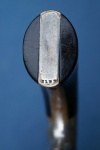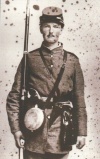
|
Rare Smith and Wesson 1st Model, First Issue Revolver, World's FIRST Cartridge Gun! |
Nice example of a Smith & Wesson Model One, First Issue Revolver. Standard single action spur trigger with seven-shot cylinder. This landmark gun was the world's first successful cartridge gun, making it the great-grandfather to all cartridge weapons. It was introduced in 1857 and produced until 1860. While it was small and fired a small .22 caliber self contained cartridge (Mark Twain once compared it to a "homeopathic pill") its technological impact spelled the beginning of the end for 500 years of muzzleloading. Really amazing when you think that in less than a fifty year span, the world went from hand-made flintlocks to cartridge guns with interchangeable parts. When this revolver came out in the late 1850s, it made powder, cap, and ball weapons extinct in less than twenty years. As it was produced in the early years of the industrial revolution, Smith and Wesson made only about 11,000 of these revolvers and they sort of learned and made improvements all along the way. During the three years of production of the Model One, Daniel and Horace made six notable improvements. Today, collectors note these variations as Type 1 through Type 6 with Type 1 thru 2 being the scarcest and most valuable. This particular example is one of the lower serial numbers we've had as it's in the 2,100 range. It is a Type 3 and was built (according to S&W records) between September and December 1858. As the barrel tip-upwards via a small hinge located at the top front of the frame, Smith and Wesson had to find a way to latch the lower portion of the barrel lug tightly to the frame. The first two Types used a long spring nicknamed the "bayonet latch". The 3rd Type used an improved latch spring loaded latch on the bottom of the barrel which locked into a small notch on the lip of the frame. Today, there are only a handful of known Type 1's that fetch five figure price tags and Type 2's usually bring $5-10K. That said, the Type 3 is the earliest variation of the Model One that is affordable and it still has some very interesting early features. This includes the fascinating revolving recoil shield design with an internal ratchet. See photo. Usually, we think of a revolver as having its ratchet as a part of the cylinder but S&W broke this down into two components at first. The barrel attaches to the face of the shield via a small pin or key. It also has the early three groove rifling. Then there are the features that all Model Ones share such as the rounded frame, the small round sideplate to access the mechanics, and the two-piece hammer design with pivoting spur to unlock the cylinder bolt from the top of the frame. These were all great features but they were delicate and prone to breakage not to mention the small access plate probably caused a great deal of angst to early gunsmiths. Today, it's hard to find one that is in good mechanical order but this one works perfectly. Overall condition grades to NRA Antique Very Good with 60% original silver plating remaining on the brass frame and 10% original blue on the barrel in the protected areas. The balance of the steel on the barrel and cylinder have turned to a smooth grey to brown patina with nice edges. The Smith and Wesson barrel address is perfect and the tiny April 3, 1855 Rollin White Patent on the cylinder is worn but still legible. The original rosewood grips are solid and numbered to the gun. Cylinder still cocks, indexes, and locks while the barrel latches tight to the frame with a good solid hinge. For such a complex piece of machinery, it's in amazing shape for 159 years old. Many of these Model Ones saw service in the Civil War as they were popular with soldiers who privately purchased them as backup weapons. During the war where armies lived for the most part out in the elements, these early seven-shooters gained a good reputation due to the fact that their .22 caliber self-contained cartridges were waterproof. Item# 1698 SOLD |
 |
 |
 |
 |
 |
 |
 |
 |
 |
 |
 |
 |
 |
 |
 |
 |
 |
 |
 |
 |
 |
 |
 |
 |